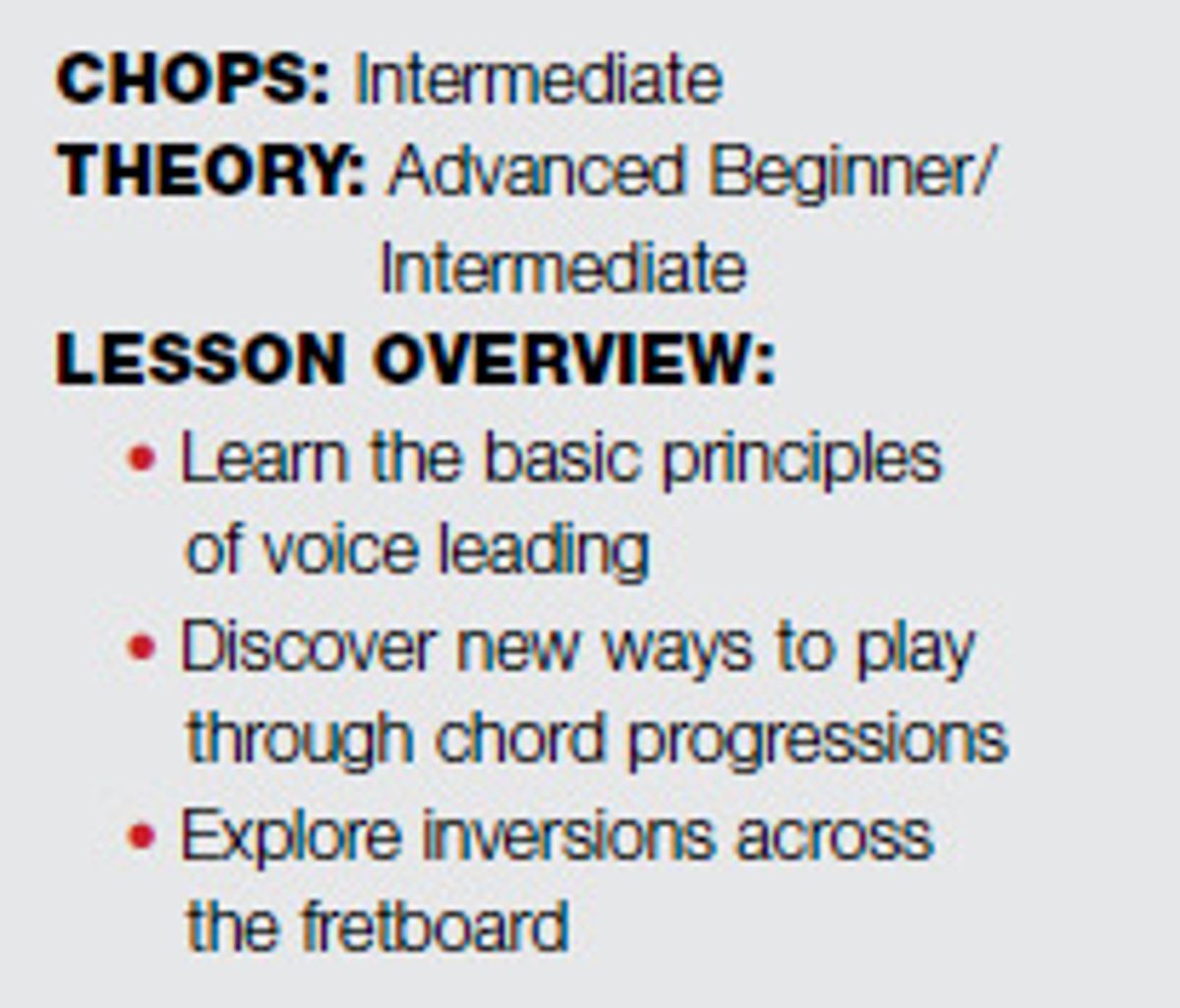
As chords move from one to the next in vocal music, the music flows most naturally when each singer sings a smooth melodic line, connecting the notes without awkward leaps.
Guitarists tend to think of chords in
terms of fretboard grips. But remember,
the concept of chordal harmony has
been around a lot longer than the guitar.
Harmony began eons ago as the result of
people singing different notes together
that sounded naturally sweet to the ear. As
chords move from one to the next in vocal
music, the music flows most naturally when
each singer sings a smooth melodic line,
connecting the notes without awkward
leaps. This is called voice leading, and we
can approach chordal movement similarly
on the guitar, for similarly smooth results.
Play Fig. 1, a simple I–IV–V–I progression in the key of C major. You can think of the starting C major chord as four voices (C–E–G–C, low to high). Note that as we move to the F major chord, the top voice remains on the same note (C), the voice below that moves just one whole-step (G to A), and the next voice below moves only a half-step (E to F). Tallying just those three voices—and overlooking the movement of the bottom voice for now—we could say that the cumulative movement is one-and-a-half total steps (G to A, plus E to F). To hear the voice leading most clearly, try playing Fig. 1 again, but sounding only the top three voices. Note that the bottom voice leaps more than the others. The bottom voice in voice leading is often allowed more independence in order to define root motion clearly (in this case, I–IV–V–I) or to follow its own melodic logic.

As we saw in the first example, voice leading takes care of itself, more or less, when we play in open position. However, when we get into keys where open-position chords aren’t available, most guitarists default to using barre chords, and smooth voice leading is given up in favor of common memorized grips.
Try this: Play a I–IV–V–I progression in the key of Bb major using common barre shapes with no regard for voice leading. There’s nothing wrong with this, yet you can get a more lyrical flow by applying voice leading to this progression. The first step is to settle on a clear melody.
Check out Fig. 2 and start by playing only the top voice of each chord (the notes D–Eb–C–D). As in Fig. 1, the most direct voice leading can be seen in the top three notes, while the bottom voice moves more freely. Go back and play the barre-chord version of our Bb I–IV–V–I progression and then Fig. 2 once more. Can you hear the difference voice leading makes?

Now play Fig. 3, which is a variation on Fig. 2, with same the melody on top, slightly different chord voicings, and a less adventurous bottom line.

While I–IV–V–I progressions are fairly common in pop music, voice leading can be used to streamline chord progressions that might otherwise sound herky-jerky. Take, for example, the intro to George Harrison’s “Something.” The song is in the key of C major, and the intro chords are F–Eb–G–C. That Eb chord doesn’t belong in this key, and going from Eb to G is not the most natural chord movement. As a general rule, chords move most smoothly by a fourth or fifth—say, from C to F or G—or by stepwise root motion—from C to Dm, for example. We can use voice leading to sweeten the sound of this chord progression, as shown in Fig. 4. Notice that the top voice inches upward in the last three chords as the bass line steps downward.

Eric Clapton’s “Bell Bottom Blues” is another classic song built on a progression that contains an unexpected chord. In the key of C major once again, the verse chords are C–E–Am–C–F–G–F–G. That second chord, E major, is the odd man out, not belonging to the key of C. On the original recording, from the 1970 Derek and the Dominos album Layla and Other Assorted Love Songs, Clapton uses open-position chords and a descending bass line to gracefully connect the dots. Fig. 5 is similar to his approach.

It may be tricky to appreciate the voice leading here, as the chords are broken into arpeggios. To focus on the harmonic motion without any rhythmic distractions, try playing each chord without arpeggiating it. Now we can more easily see how the top voice in the first three chords goes chromatically upward while the bottom voice goes downward scale-wise. Smooth move, Slowhand.
We can use the same sort of voice-leading strategy on even thornier chord progressions— such as Kurt Cobain’s “Lithium” from the Nirvana album Nevermind. The song is in the key of D major, and the verse chord progression is D–F#–Bm–G–Bb–C– A–C. The chords D, Bm, G, and A belong in the key, while F#, Bb, and C do not. Played as full barre chords, or as root-and-fifth power chords (see Fig. 6), the progression has a punk-rock edge.

It takes on a breezier, almost Beatlesque quality in Fig. 7, when we use voice leading to string the chords along. Of course, sanding the rough edges off of Nirvana may seem heretical to some, but that’s not the point here. The point is that harmony is universal, and its laws apply across borderlines. Thus, voice leading can be applied to virtually any chord progression, regardless of musical genre.

Now it’s your turn to take voice leading for a test drive. Apply it to the chords in your own songs, or even just one section of the song, so that the effect stands out. You might also try re-arranging a cover song with voice leading in mind. As with any musical skill, voice leading gets easier the more you work at it, so get at it and keep at it until it’s second nature.
 Adam Levy
Adam Levy
Adam Levy is best known for his tenure as the featured guitarist in Norah Jones’ Handsome Band. He played on her breakout 2002 CD, Come Away with Me, as well as her subsequent two albums. Levy has also recorded several albums on his own. His latest is The Heart Collector. Visit adamlevy.com for more information.
Play Fig. 1, a simple I–IV–V–I progression in the key of C major. You can think of the starting C major chord as four voices (C–E–G–C, low to high). Note that as we move to the F major chord, the top voice remains on the same note (C), the voice below that moves just one whole-step (G to A), and the next voice below moves only a half-step (E to F). Tallying just those three voices—and overlooking the movement of the bottom voice for now—we could say that the cumulative movement is one-and-a-half total steps (G to A, plus E to F). To hear the voice leading most clearly, try playing Fig. 1 again, but sounding only the top three voices. Note that the bottom voice leaps more than the others. The bottom voice in voice leading is often allowed more independence in order to define root motion clearly (in this case, I–IV–V–I) or to follow its own melodic logic.
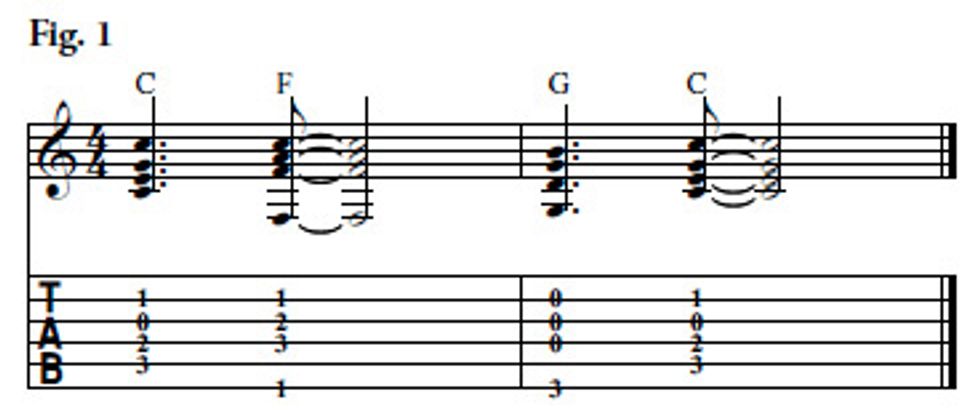
As we saw in the first example, voice leading takes care of itself, more or less, when we play in open position. However, when we get into keys where open-position chords aren’t available, most guitarists default to using barre chords, and smooth voice leading is given up in favor of common memorized grips.
Try this: Play a I–IV–V–I progression in the key of Bb major using common barre shapes with no regard for voice leading. There’s nothing wrong with this, yet you can get a more lyrical flow by applying voice leading to this progression. The first step is to settle on a clear melody.
Check out Fig. 2 and start by playing only the top voice of each chord (the notes D–Eb–C–D). As in Fig. 1, the most direct voice leading can be seen in the top three notes, while the bottom voice moves more freely. Go back and play the barre-chord version of our Bb I–IV–V–I progression and then Fig. 2 once more. Can you hear the difference voice leading makes?
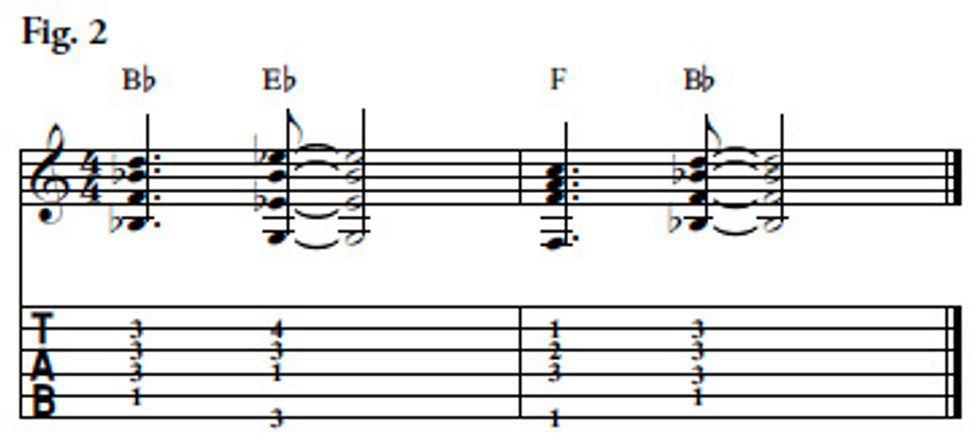
Now play Fig. 3, which is a variation on Fig. 2, with same the melody on top, slightly different chord voicings, and a less adventurous bottom line.
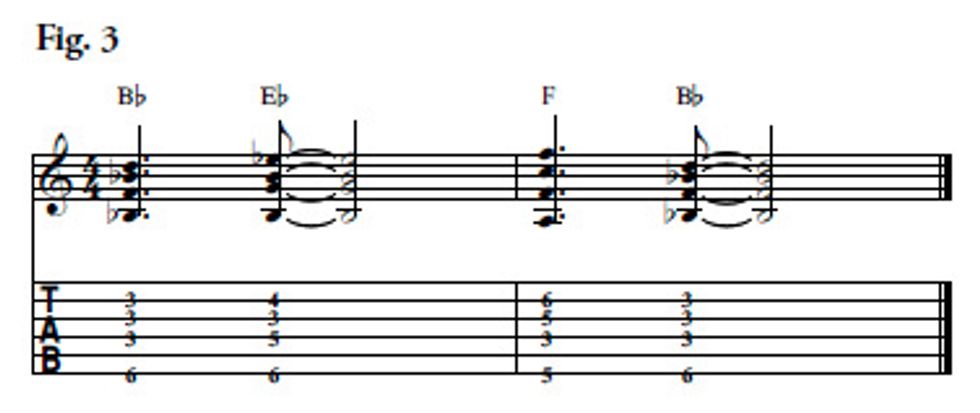
While I–IV–V–I progressions are fairly common in pop music, voice leading can be used to streamline chord progressions that might otherwise sound herky-jerky. Take, for example, the intro to George Harrison’s “Something.” The song is in the key of C major, and the intro chords are F–Eb–G–C. That Eb chord doesn’t belong in this key, and going from Eb to G is not the most natural chord movement. As a general rule, chords move most smoothly by a fourth or fifth—say, from C to F or G—or by stepwise root motion—from C to Dm, for example. We can use voice leading to sweeten the sound of this chord progression, as shown in Fig. 4. Notice that the top voice inches upward in the last three chords as the bass line steps downward.
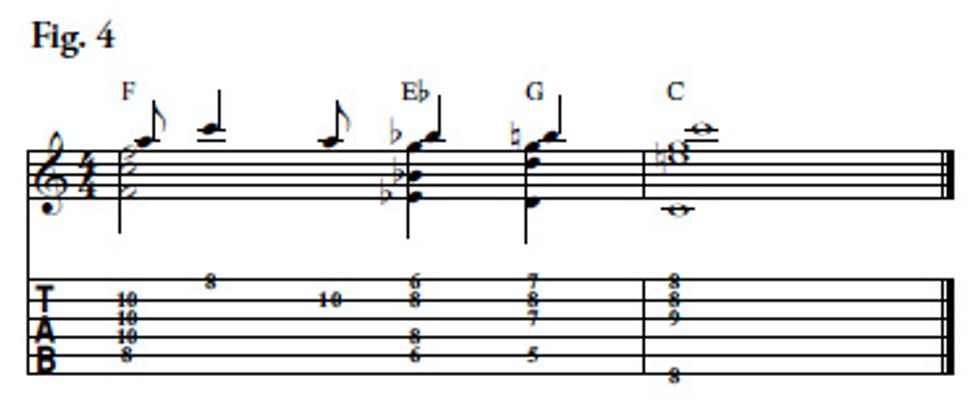
Eric Clapton’s “Bell Bottom Blues” is another classic song built on a progression that contains an unexpected chord. In the key of C major once again, the verse chords are C–E–Am–C–F–G–F–G. That second chord, E major, is the odd man out, not belonging to the key of C. On the original recording, from the 1970 Derek and the Dominos album Layla and Other Assorted Love Songs, Clapton uses open-position chords and a descending bass line to gracefully connect the dots. Fig. 5 is similar to his approach.

It may be tricky to appreciate the voice leading here, as the chords are broken into arpeggios. To focus on the harmonic motion without any rhythmic distractions, try playing each chord without arpeggiating it. Now we can more easily see how the top voice in the first three chords goes chromatically upward while the bottom voice goes downward scale-wise. Smooth move, Slowhand.
We can use the same sort of voice-leading strategy on even thornier chord progressions— such as Kurt Cobain’s “Lithium” from the Nirvana album Nevermind. The song is in the key of D major, and the verse chord progression is D–F#–Bm–G–Bb–C– A–C. The chords D, Bm, G, and A belong in the key, while F#, Bb, and C do not. Played as full barre chords, or as root-and-fifth power chords (see Fig. 6), the progression has a punk-rock edge.

It takes on a breezier, almost Beatlesque quality in Fig. 7, when we use voice leading to string the chords along. Of course, sanding the rough edges off of Nirvana may seem heretical to some, but that’s not the point here. The point is that harmony is universal, and its laws apply across borderlines. Thus, voice leading can be applied to virtually any chord progression, regardless of musical genre.

Now it’s your turn to take voice leading for a test drive. Apply it to the chords in your own songs, or even just one section of the song, so that the effect stands out. You might also try re-arranging a cover song with voice leading in mind. As with any musical skill, voice leading gets easier the more you work at it, so get at it and keep at it until it’s second nature.
 Adam Levy
Adam LevyAdam Levy is best known for his tenure as the featured guitarist in Norah Jones’ Handsome Band. He played on her breakout 2002 CD, Come Away with Me, as well as her subsequent two albums. Levy has also recorded several albums on his own. His latest is The Heart Collector. Visit adamlevy.com for more information.
From Your Site Articles

